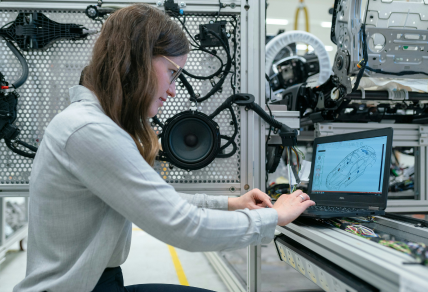1. What is Virtual Reality (VR)?
Answer:
Virtual Reality (VR) is a computer-generated environment that simulates a realistic experience, either similar to or entirely different from the real world. Users interact with this environment using VR headsets, motion controllers, and other sensory equipment.
2. How does VR differ from augmented reality (AR)?
Answer:
VR completely immerses users in a virtual environment, blocking out the real world.
AR overlays digital information onto the real world, allowing users to interact with both the physical and virtual environments at the same time.
3. What equipment is needed for a basic VR setup?
Answer:
A basic VR setup typically requires:
A VR headset (e.g., Oculus Quest, HTC Vive, PlayStation VR)
Controllers for interaction (motion or standard controllers)
A PC or gaming console (for high-end VR systems, like HTC Vive or Oculus Rift)
Some space for moving around in space (playspace)
4. How does it work?
How does VR?
VR works with the stereoscopic images that get shown to every eye, a sense of depth. The user would be wearing the headset with a sensor that catches head movements. Images are manipulated based on such head movements and then controllers and hand-tracking tools help interact with that virtual environment.
5. What are the applications of VR in the workplace?
Answer:
VR in the workplace is used for:
Remote collaboration (virtual meetings, presentations)
Training simulations (for high-risk professions such as healthcare or aviation)
Virtual conferences and events
Product design and prototyping
Employee wellness programs (meditation, stress relief)
6. How does VR apply to training and education?
Answer:
VR offers highly immersive learning experiences in fields like:
Medical training (surgery simulations)
Military training (combat and tactical simulations)
Industrial training (safety procedures, equipment handling)
Classroom education (virtual field trips, interactive lessons)
7. What are the advantages of VR in business?
Answer:
Advantages of VR in business include:
Improved customer and employee engagement
Low-cost employee training with no risk in the real world
Better remote team collaboration
Improved product design through virtual prototyping
Increased productivity through immersive and interactive tools
8. Is it possible to use VR for remote work?
Answer:
Yes, VR can improve remote work by:
Creating virtual offices where employees can collaborate in real-time
Holding virtual meetings in 3D environments
Providing a sense of presence, which can improve communication and team dynamics
9. What is VR gaming?
Answer:
VR gaming is the utilization of virtual reality technology to give video game experience in an immersive manner. It enables players to interact with the 3D virtual world through a headset, controllers, and sometimes even haptic feedback devices. It makes games more interactive and real.
10. How is a VR game different from traditional games?
Answer:
VR games offer
Immersive 3D environments that players can interact with directly
First-person perspective to increase immersion
Physical interaction (e.g., movement, hand gestures)
Presence and spatial awareness, unlike traditional games where players control characters from a screen
11. What are some popular VR games for entertainment?
Answer:
Some popular VR games include:
Beat Saber (rhythm-based game)
Half-Life: Alyx (first-person shooter)
Superhot VR (action strategy game)
The Walking Dead: Saints & Sinners (horror)
Rec Room (social VR experiences)
12. Can VR be used for fitness?
Answer:
Yes, VR fitness apps like Supernatural, FitXR, and BoxVR provide interactive workouts, turning exercise into a fun, immersive experience. Users can engage in activities like boxing, dancing, or yoga while tracking fitness goals.
13. What are the potential health benefits of VR?
Answer:
Health benefits of VR include:
Stress relief and relaxation through virtual meditation apps
Pain management for chronic pain patients
Physical rehabilitation via exercise-based VR games
Mental health applications, such as exposure therapy for treating PTSD or anxiety
14. How does VR facilitate social interaction?
Answer:
Through virtual environments where users can meet, chat, and collaborate, VR enables social interaction. The social VR platforms-VRChat and AltspaceVR- enable people to create avatars and socialize across geographical locations.
15. In what ways will VR enhance virtual conferences and events?
Answer:
VR enhances virtual conferences by providing:
Virtual immersive spaces for networking and attending sessions
Interactive exhibitions of 3D product demos
Avatar-based communication for more lifelike conversations
Save travel costs while maintaining a “live” conference
16. What is a “virtual office” in VR?
Answer:
Virtual offices in VR provide the ability for employees to work from a simulated, 3D office environment. Virtual office software such as Spatial or Rumii enable team members to interact with one another, hold meetings, share documents, and collaborate on projects in an immersive environment than the video calls that everyone is accustomed to.
17. How can product prototyping be applied using VR?
Answer:
It allows designers and engineers to create virtual prototypes of products that can be tested, modified, and evaluated in 3D before the physical production of them. This helps speed up the design process, reduces costs, and gives immediate feedback for iteration.
18. What are the limitations of VR for work?
Answer:
Limitations of VR for work include:
Cost of hardware (VR headsets, controllers, and computers)
Motion sickness in some users
Limited content for certain industries
User discomfort (due to weight of headsets or long usage)
19. How do VR headsets impact users’ physical health?
Answer:
Long-term use of VR can cause:
Eye strain or fatigue from prolonged screen exposure
Motion sickness or vertigo due to lag or mismatched movement
Neck and back pain from poor posture or weight of the headset However, these can be mitigated with proper ergonomics and regular breaks.
20. Which VR platforms are most popular for gaming?
Answer:
Some of the most popular VR platforms for gaming are:
Oculus Rift / Quest
HTC Vive / Vive Pro
PlayStation VR
Valve Index
PCVR (SteamVR)
21. Is it possible to use VR for remote team-building exercises?
Answer:
Yes, VR is increasingly used for virtual team-building activities, such as:
Collaborative problem-solving games
Escape rooms or other challenges in virtual environments
Team-based VR games that require communication and coordination
22. How is VR applied in healthcare?
Answer:
VR is applied in healthcare for:
Surgical training through virtual simulations
Pain management and stress relief
Physical rehabilitation through movement-based VR games
PTSD, anxiety, and phobia therapy through exposure therapy
23. What are the typical types of VR headsets?
Answer:
Typical headsets involve:
Oculus Quest 2 (self-contained)
HTC Vive Pro (PC-based)
PlayStation VR (console-based)
Valve Index (PC-based)
Pico Neo (self-contained)
24. How does VR increase workplace creativity?
Answer:
VR may enhance creativity through:
Employees’ ability to experience and envision ideas in 3D
Providing virtual environments to brainstorm and collaborate in new ways
Design tools for virtual spaces, products, and prototypes
Immersive experiences inspiring fresh ideas
25. What are VR escape rooms?
VR escape rooms are immersive puzzle games where players solve challenges in virtual environments. Teams of players must work together to uncover clues, solve riddles, and escape from a digital room before time runs out.
26. Can VR decrease the travel costs of businesses?
Answer:
Yes, VR decreases travel costs since it allows for virtual meetings, conferences, and trade shows. Employees and clients can meet within an immersive environment, thus obviating physical travel while allowing for face-to-face contact.
27. What are some of the other entertainment purposes that VR has?
Answer:
Beyond gaming, VR is applied to:
Virtual tourism (to see new places from home)
360-degree movies for a more immersive view
Live performances of concerts or sports events with front-row experience
Interactive storytelling and immersive theater
28. What are the implications of VR for the entertainment industry?
Answer:
VR affects the entertainment industry by:
Developing more interactive experiences, such as immersive movies or theme parks
Enabling fans to attend virtual live events from anywhere
Enriching storytelling with 360-degree narratives
29. What are the risks associated with VR?
Answer:
Potential risks of VR include:
Motion sickness or discomfort due to disorientation
Physical injury (for example, bumping into things while immersed)
Overuse causing eye strain or headaches
Virtual addiction that affects real life interactions
30. How does VR apply in architecture and design?
Answer:
In architecture and design, VR supports by:
Virtual walkthroughs of buildings and spaces before actual construction
Client experiencing designs and providing immediate feedback
Simulation of the effects of lighting, materials, and layouts for design refinement
31. What are the primary difficulties of applying VR in business?
Answer:
Challenges of using VR in business include:
High initial setup costs for equipment
Content limitations for specific business applications
User comfort issues (e.g., VR fatigue or motion sickness)
Technical issues such as software compatibility and lag
32. Can VR improve mental health?
Answer:
Yes, VR has been used to improve mental health by:
Providing stress relief through relaxation apps
Offering exposure therapy for anxiety, PTSD, and phobias
Facilitating meditation and mindfulness exercises in immersive environments
33. What is the future of VR in the workplace?
Answer:
The future of VR in the workplace encompasses:
Widespread use of virtual offices for remote work
Advanced training simulations for high-risk industries
Increased use of immersive collaboration tools for global teams
More customized VR environments tailored to specific business needs
34. How does VR enhance user engagement?
Answer:
VR enhances engagement by:
Creating immersive and interactive experiences that capture attention
Providing a feeling of presence that makes users more connected
Showing personalized content relevant to the activities and preferences of the user
35. Will VR aid in learning skills?
Response:
Yes, VR is successful in learning and mastering skills through:
Medical procedure (surgical techniques)
Customer service- simulated interaction with customers
Technical skills-machining or computer programming
36. How may businesses apply VR to their advertising campaigns?
Answer:
Business can use VR as an advertising platform by:
Hosting virtual product demo
Hosting immersive brand experiences at events or trade shows
Providing virtual tours of products or services
Creating interactive ads or experiences that engage consumers
37. How does VR promote inclusivity and accessibility?
Answer:
VR can promote inclusivity by:
Creating environments that are accessible to people with disabilities
Allowing for remote participation in events, meetings, and activities
Providing immersive learning and therapeutic experiences for various abilities
38. How is VR used in the field of sports?
Answer:
In sports, VR is applied in:
Training simulations for athletes to practice scenarios
Fan engagement, such as virtual stadium tours and live event experiences
Recovery and rehabilitation for injured athletes through movement-based exercises
39. What is the role of VR in the future of education?
Answer:
In education, VR will enable
Interactive learning experiences that increase engagement
Virtual field trips to historical sites, museums, and science labs
Hands-on simulations for complex topics like anatomy or physics
40. How is VR changing the gaming industry?
Answer:
VR is changing the gaming industry by:
Giving players a more immersive and interactive game
Enabling players to touch and feel the game world
Creating new genres of games designed for VR, such as escape rooms and fitness games
Conclusion
Virtual Reality is no longer just a novelty for entertainment but is becoming a critical tool for business, education, healthcare, and many other industries. The more the technology advances, the more possibilities it has to open up new ways of working, learning, and playing.





